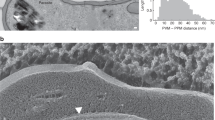Abstract
DURING its 48-hour cycle inside the red blood cell, the human malaria parasite, Plasmodium falciparum, increases its volume 25-fold and divides asexually. This rapid growth demands large amounts of nutrients, a problem exacerbated by the lower metabolic rate and relative ionic impermeability of the host red blood cell. Direct passage of small nutrients across the two membranes that separate the parasite from the erythrocyte cytosol may be important for parasite development1 and has been demonstrated for radiolabelled glucose2, amino acids3,4 and purine nucleo-sides4–6. Flux studies on plasmodia are limited, however, to suspensions of erythrocyte-free parasites and so cannot be used to examine the individual transport properties of the two membranes involved. Here we use the cell-attached patch clamp method7 to overcome this limitation. After removing the intervening red blood cell membrane and forming gigaohm seals on the small (3–5 μm) parasite, we studied transport across the parasitophorous vacuole membrane (PVM), the outer of the two membranes that separate the parasite from the erythrocyte cytosol. A 140-pS channel which is permeable to both cations and anions was identified on the PVM. This channel is present at high density, is open more than 98 per cent of the time at the resting potential of the PVM, and is permeable to lysine and glucuronate. The channel can readily transport amino acids and monosaccharides across the PVM and may be essential for fulfilling the parasite's metabolic demands.
Similar content being viewed by others
References
Sherman, I. W. Parasitology 96, S57–S81 (1988).
Tanabe, K. Parasit. Today 6, 225–229 (1990).
Trager, W. J. Protozool. 18, 392–399 (1971).
Sherman, I. W. Bull. World Health Org. 55, 211–225 (1977).
Hansen, B. D., Sleeman, H. K. & Pappas, P. W. J. Parasit 66, 205–212 (1980).
Kanaani, J. & Ginsburg, H. J. biol. Chem. 264, 3194–3199 (1989).
Hamill, O. P., Marty, A., Neher, E., Sakmann, B. & Sigworth, F. J. Pflügers Arch. 391, 85–100 (1981).
Langreth, S. G. Bull. World Health Org. 55, 171–178 (1977).
Yamada, K. A. & Sherman, I. W. Molec. biochem. Parasit. 3, 253–264 (1981).
Wibo, M., Thinés-Sempoux, D., Amar–Costesec, A., Beaufay, H. & Godelaine, D. J. Cell Biol. 89, 456–474 (1981).
Dwyer, T. M., Adams, D. J. & Hille, B. J. gen. Physiol. 75, 469–492 (1980).
Jap, B. K. & Walian, P. J. Q. Rev. Biophys. 24, 367–403 (1990).
Hunter, M. & Giebisch, G. Nature 327, 522–524 (1987).
Gero, A. M. & Wood, A. M. Adv. exp. Med. Biol. 309A, 169–172 (1991).
Ginsburg, H. Comp. biochem. Physiol. 95A, 31–39 (1990).
Colombini, M. Nature 279, 643–645 (1979).
Benz, R. CRC crit. Rev. Biochem. 19, 145–190 (1985).
Bennett, M. V. L. et al. Neuron 6, 305–320 (1991).
Pouvelle, B. et al. Nature 353, 73–75 (1991).
Haldar, K. & Uyetake, L. Molec. biochem. Parasit. 50, 161–177 (1992).
Lee, P., Ye, Z., Van Dyke, K. & Kirk, R. G. Am. J. trop. Med. Hyg. 39, 157–165 (1988).
Mikkelsen, R. B., Wallach, E. F. H., Van Doren, E. & Nillni, E. A. Molec. biochem. Parasit. 21, 83–92 (1986).
Izumo, A., Tanabe, K. & Kato, M. Comp. biochem. Physiol. 91B, 735–739 (1988).
Slater, A. F. G. & Cerami, A. Nature 355, 167–169 (1992).
Goldberg, D. E. et al. J. exp. Med. 173, 961–969 (1991).
Schroeder, J. E., Fischbach, P. S., Zheng, D. & McCleskey, E. W. Neuron 6, 13–20 (1991).
Trager, W. & Jensen, J. B. Science 193, 673–675 (1976).
Lambros, C. & Vanderberg, J. P. J. Parasit. 65, 418–420 (1979).
Franciolini, F. & Wolfgang, N. J. gen. Physiol. 90, 453–478 (1987).
Author information
Authors and Affiliations
Rights and permissions
About this article
Cite this article
Desai, S., Krogstad, D. & McCleskey, E. A nutrient-permeable channel on the intraerythrocytic malaria parasite. Nature 362, 643–646 (1993). https://doi.org/10.1038/362643a0
Received:
Accepted:
Issue Date:
DOI: https://doi.org/10.1038/362643a0
- Springer Nature Limited
This article is cited by
-
The parasitophorous vacuole of the blood-stage malaria parasite
Nature Reviews Microbiology (2020)
-
Contacting domains segregate a lipid transporter from a solute transporter in the malarial host–parasite interface
Nature Communications (2020)
-
Spotlight on proteins that aid malaria
Nature (2018)
-
EXP2 is a nutrient-permeable channel in the vacuolar membrane of Plasmodium and is essential for protein export via PTEX
Nature Microbiology (2018)
-
Transfection with thymidine kinase permits bromodeoxyuridine labelling of DNA replication in the human malaria parasite Plasmodium falciparum
Malaria Journal (2015)





